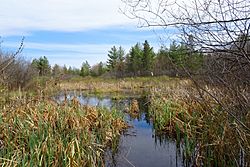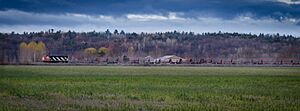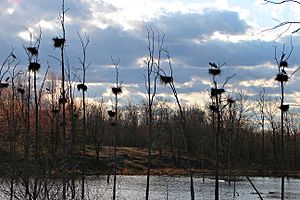Carp Hills facts for kids
Quick facts for kids Carp Hills |
|
|---|---|
| Carp Ridge | |
 |
|
| Highest point | |
| Elevation | 129 m (423 ft) |
| Dimensions | |
| Area | 4,000 ha (10,000 acres) |
| Geography | |
|
Lua error in Module:Location_map at line 416: Malformed coordinates value.
|
|
| Country | Canada |
| Province | Ontario |
| Settlement | Ottawa |
| Range coordinates | Lua error in Module:Coordinates at line 614: attempt to index field 'wikibase' (a nil value). |
The Carp Hills (also called Carp Ridge) are a group of rocky hills in Ottawa, Ontario, Canada. They are located between the Carp River and Constance Creek. These hills stretch from Kinburn Side Road to the village of Carp.
The Carp Hills cover about 4,000 hectares (10,000 acres). Most of this area is natural and undeveloped. The hills are part of the Canadian Shield, which is a very old rock formation. The landscape here has rocky areas, grasslands, marshes, and many small ponds. There are also patches of old forests. People often compare the wild beauty of the Carp Hills to Gatineau Park. It is known as a very special natural place.
Many people enjoy the Carp Ridge for outdoor activities. You can go hiking, hunting, or cross-country skiing there. Snowmobiling is also popular in winter. Some popular trails include the Carp Barrens Trail, which is 3 kilometers long. The Crazy Horse trail is a 6.2-kilometer loop. You can also find pathways at Hidden Lake Park in Carp village.
Contents
What Makes the Carp Hills Unique?
The Carp Hills are special because they are made of very old rock called Precambrian bedrock. Most of Ottawa is quite flat, so these rocky hills stand out. The geology here is complex. It includes rocks like gneiss, granite, and marble.
Different Types of Forests and Plants
The hills support many different types of plants and landforms. You can find old forests with both deciduous (trees that lose leaves) and mixed trees. There are also lowland forests with mixed and coniferous (evergreen) trees. These types of forests are rare in this part of Ontario. Like other areas of the Canadian Shield, the Carp Hills have rolling land. They also have thin soil and areas with very little plant growth.
A part of the hills called the Carp Barrens is very unique. It has the largest and best examples of granite bedrock barrens. This is true not only for the Carp Ridge but also for all of southern Ontario east of the Thousand Islands – Frontenac Arch.
Fault Lines and Old Mines
On the western side of the hills, you can see an exposed fault. This creates a ridge that offers great views of the countryside. The gneiss rock in the Carp Barrens contains mica. Long ago, two small mines used to operate there to collect mica.
Animals and Plants of the Carp Hills
The Carp Hills are home to a huge variety of living things. More than 600 different types of plants and animals live here. This includes some species at risk. The wetlands in the hills help keep the Carp River clean all year. They do this through surface streams and underground aquifers. These aquifers also provide water for local wells.
Amazing Plant Life
The variety of plants in the Carp Hills is truly amazing. Nearly 180 different kinds of plants have been found. Some of these plants are rare in the province or region.
Common trees include white pine, white spruce, and different types of maple and oak. You can also find trembling aspen, white birch, and common juniper.
Other plants found here include different kinds of orchids. These include the showy orchid (Galearis spectabilis). You might also see ricegrass (Oryzopsis racemosa) and bottlebrush grass (Elymus hystrix). Blueberries (Vaccinium spp.) and staghorn sumac (Rhus typhina) also grow here. The hills are also home to many types of liverworts, mosses, and lichens.
Wildlife You Might See
The Carp Hills are home to many animals. You might spot coyotes, white-tailed deer, and even black bears. Other animals include beavers, porcupines, and different kinds of turtles. Chipmunks, snowshoe hares, and squirrels also live here.
Many types of birds live in the hills. These include songbirds, waterfowl, and birds of prey. You might see herons, red-tailed hawks, and great horned owls. Other birds include common nighthawks and pileated woodpeckers.
It's good to know that ticks are common in the Carp Hills. Most of these are black-legged ticks. Some of them carry the bacteria that causes Lyme disease.
Protecting the Carp Hills
People have known how important the Carp Hills are for a long time. As early as 1971, it was suggested that they become a protected area. This would be similar to the Mer Bleue Conservation Area in eastern Ottawa. However, this idea was stopped due to pressure from landowners.
In 2012, a new plan from the National Capital Commission (NCC) called the Carp Hills a very important natural area. They suggested creating a natural corridor. This would connect the hills to the Ottawa Greenbelt through the South March Highlands.
The provincial government has named the Carp Hills as a possible Area of Natural and Scientific Interest (ANSI). Many parts of the hills are also recognized as Provincially Significant Wetlands (PSW). However, it wasn't until 2018 that an area was officially protected. That year, Ducks Unlimited bought a large piece of land near Carp village. This land, about 178 hectares (440 acres), was purchased for conservation.
The city of Ottawa also owns several separate pieces of land in the hills. These lands total about 1,000 hectares. They are set aside for environmental protection and outdoor recreation. However, most of the Carp Ridge is still privately owned and not protected. Even so, local zoning bylaws do limit how much development can happen there.



